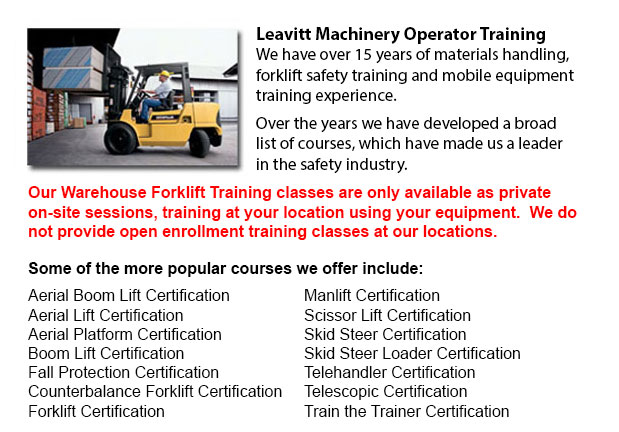
Warehouse Forklift Training Programs Red Deer - Warehouses could either be industrial, commercial or retail facilities, functioning from bulk product retailing to product distribution services. Regardless of the type of warehouse, employees within warehouse settings should be trained correctly in safety procedures related to material handling and storage, conveyor systems, loading docks, and forklifts and pallet jacks. Good housekeeping is vital to an orderly and safe warehouse setting.
Truck and loading dock systems are often located at a height from the ground. Products enter and exit warehouses through these systems where employees load and unload materials from elevated docks and ramps. Particular attention should be paid to safety practice throughout this stage. In order to prevent falls, install yellow striping along the edge of docks and ramps. Pay attention to the area all-around delivery trucks that are parked at the loading dock, particularly the area between dock and the truck. Be certain that when unloading, truck wheels are chocked.
Some warehouses utilize conveyor systems to distribute products in the facility. Conveyor systems have moving wheels and belts which pose a pinch point hazard. Keep parts of the body and hair well away from conveyors to prevent injury. Elevated conveyors pose a hazard to workers below if safety nets are absent. Workers should know how to stop conveyors in case of emergency. Be aware of the location of emergency stop buttons and off switches. When servicing conveyors, lock out/tag out procedures are mandatory.
To be able to make it easier to transport materials, pallet jacks and forklifts are most normally used. The lift truck operator will require training and certification. Pallet jack operators do not need certification, but must be trained about the machine. Training courses instruct operators in the proper methods for lifting objects and transporting them to their assigned location. Neither forklifts nor pallet jacks should ever be used to transport or lift personnel.
Rack system and storage shelving help to create an efficient and orderly work area if they are braced, sturdy, and allow sufficient room for individuals and equipment to pass. Slow and careful placement of good is required to avoid accidents caused by products falling off the facing aisle. Aisles should be kept clear by storing products flat and in the shelving units. Pallets are utilized for stacking products. They must be in good condition, and palleted products should be shrink-wrapped or baled, whenever possible.
Personal protective equipment (or likewise known as PPE) must be worn, as appropriate, to protect employees' heads, limbs, feet and hands. Bump caps or hard hats, steel-toed shoes and gloves are common PPE.
Slippery floors pocked with pits and dents present a danger. Good housekeeping practices involve keeping warehouse docks and floors clear of dirt, debris and oil. The space must be kept clear of boxes, baling supplies and trash.
-
Fall Protection Ticket Red Deer
Fall Protection Ticket Red Deer - The number one reason of death in the construction industry come from fall-related incidents. There is more possibility for fall accidents depending upon the kinds of work being done in your workplace. Therefore, kno... More -
Overhead Crane Certification Red Deer
Overhead Crane Certification Red Deer - The overhead crane certification course is a course that is designed to help trainees, even if they have language or literacy limitations. The course comprises a practical hands-on training session and a classr... More -
Wheel and Track Loader Training in Red Deer
Lift trucks are obtainable in a variety of various models which have various load capacities. Nearly all typical lift trucks utilized in warehouse settings have load capacities of 1-5 tons. Bigger scale models are utilized for heavier loads, like for... More -
Heavy Equipment Certification Red Deer
Heavy Equipment Certification Red Deer - Heavy duty vehicles are big pieces of machines which are usually known as heavy equipment. It is a broad term that literally includes whatever big utility vehicle in the area of agricultural and forestry imple... More -
Heavy Equipment Operator Classes Red Deer
Heavy Equipment Operator Classes Red Deer - A person who has the correct training to be able to use a particular kind or piece of machine is referred to as an equipment operator. There are different ways that an equipment operator can become trained... More -
Forklift Training Programs Red Deer
Forklift Training Programs Red Deer - Are you searching for a job as a driver of a forklift? Our regulatory-compliant mobile equipment operator training offers instruction in kinds of lift trucks, pre-shift check, fuel types and dealing with fuels, a... More -
Crane Safety Training Red Deer
Crane Safety Training Red Deer - Both crane driver and their supervisors must know all the potential problems related to the operation of an overhead crane. All over North America, there is legislation which provides rules for the safe inspection, ma... More -
Aerial Lift Training Red Deer
Aerial Lift Training Red Deer - An aerial work platform is a mechanized access platform. This device provides access to otherwise inaccessible places for people or equipment. Likewise called an elevating work platform or aerial device, the machinery... More

Forklift Training Red Deer
TOLL FREE: 1-888-254-6157
Red Deer, Alberta
forklifttrainingreddeer.com
Email Us
About Us


